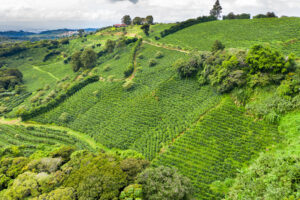This spring I had the incredible opportunity of spending a week in Costa Rica. On March 11, I landed in Costa Rica and the first thing I noticed was the smell. While crossing over the boundary between the plane and the airport, the air seeping in through the cracks where the two spaces joined was sweet. It was fragrant. I immediately knew this trip would be all about appreciating

nature. And that’s what we did. We explored the geography and learned about volcanoes and forest and plants. As we learned about these plants, we learned that agriculture is one of the top industries in Costa Rica, serving as one of the top exports of the country. As such, a significant portion of the country’s resources are allocated to the process of crop cultivation. Leading exports from Costa Rica include Bananas, Sugar, Coffee, Rice, and Dairy Products with Coffee being the country’s oldest agricultural product. The country even provides tax incentives to farmers to promote coffee exports. This is, of course, why one of our destinations on this trip was the Starbucks Coffee Farm in Sabanilla, Costa Rica. Learning about the process of coffee bean production and quality control was incredible, and one of my favorite parts of this trip.

We visited the farm both because agricultural production is at the forefront of Costa Rican exports, and also because learning about coffee plant growth allowed us to gain an understanding of and evidence of the Costa Rican climate. This included temperature, soil conditions, atmospheric moisture, and other traits that contribute to plant growth. Costa Rica is a warm, tropical country, facilitating plant growth through many months. The farm is situated in a hilly region, which causes it to rain more frequently than in other regions of this hot country. Indeed, it was drizzling on us for the entire duration of our tour of the farm.

Despite this variance and diversity within the country, Costa Rica does fall into the general tropical zone as decided by its location relative to the Equator. The average temperature ranges between about 73-89 degrees Fahrenheit. Thus the dry and wet climates and seasons within Costa Rica do still maintain high temperatures year-round.
Costa Rica’s geographical location also allows it to foster a unique biodiversity, allowing for the flourishing of various plant and animal species. Moreover, political policies regarding environmental protection and climate change cater to the protection of the biodiversity and ecosystem of Costa Rica. Together these factors contribute to the thriving biodiversity of Costa Rica. As Costa Rica has both a dry and wet season, it is able to sustain plant production for crops that thrive in both humid and drier conditions depending on the season. Geographically as well, Costa Rica has a set of diverse climate conditions. Areas around the Caribbean coast have near year-round significant rain fall while some regions along mountain ranges have moderate to lower rainfall quantities depending on the season. This is in part because the evaporation cause significant air humidity and cloud formation, but these clouds do not pass over the mountain ranges, so the rain simply pours in downfalls closer to the coast, creating the wet season. Our experience during our week, of course, was abnormal-as pointed out to us by the locals. It rained nearly every day for the week we were there, which was unusual not just for the time of year that we were there, but even for the wet season. When speaking of typical patterns though, the climate variation allows the crop growth within just this one country to vary greatly not just through the seasons but also by geographical location within the under 20,000 square mile country.
It takes years for coffee plants to begin producing fruit. They go through an active and dormant cycle as the dry and wet months cycle around. The pictures illustrate what we learned on our walking tour. Only during the wet months are fruits produced on the plant. Thus it is vital that extreme conditions do not harm the plant before it has matured the full 3 years before it begins to produce fruit. As we learned, the plants produce a significant amount of fruit used for coffee bean production for around a 20 year period, before the plants are replanted in other fields with less fruitful companions. Since moderate but warm temperatures and significant rainfall is necessary for coffee plant fruit production, Costa Rica provides the ideal climate for the plant to thrive. The higher elevated areas in Costa Rica offer less temperature fluctuation and more cool temperatures than other parts of the country which is why they also sustain coffee plants well. (Though it is also apparent that at altitudes too high, frost can be a problem). Clearly, the coffee plant requires very specific conditions to grow, which is why the Climate in Costa Rica is so important to the health of the coffee plants. Thus, the laws protecting the environment in Costa Rica are so well created as well. While we learned that all the coffee grown at the farm we visited is used for research purposes, farmers throughout the country grow their crop and bring it in barrels and buckets to be sorted, dried, measured, and quality controlled. These farmers put months of effort into growing plants whose fruit only fills one-twelfth of a container. Nevertheless, coffee is a huge industry throughout Costa Rica. It is important to note that coffee is a huge commodity around the world, not just in Costa Rica and so changing climates across the globe impact Coffee production in various ways. While I chose to focus on Costa Rica and the impact of Costa Rican climate on coffee plant growth, this topic can be viewed at a much wider scope as well. It gives all of us a little something to think about when grabbing our morning cup of coffee. Or when grabbing our 4 pm pick-me-up. But either way, we can remember the efforts of local farmers who cultivate their crop with hard work from across the world to eventually get us the precious cups of coffee that we all adore.